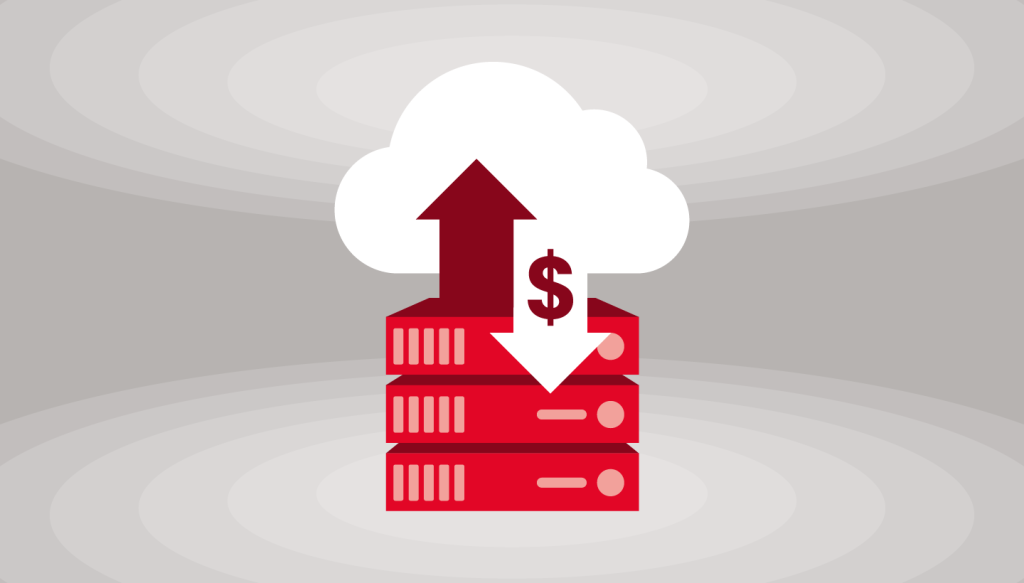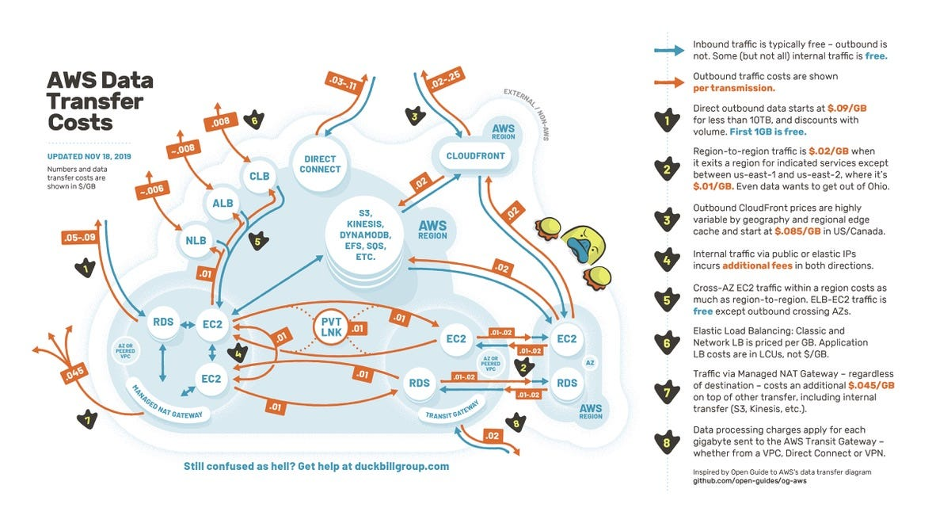
You can imagine data egress fees like tolls on a highway—your data is cruising along trying to get to its destination, but it has to pay a fee for the privilege of continuing its journey. If you have a lot of data to move, or a lot of toll booths (different cloud services) to move it through, those fees can add up quickly.
Data egress fees are charges you incur for moving data out of a cloud service. They can be a big part of your cloud bill depending on how you use the cloud. And, they’re frequently a reason behind surprise AWS bills. So, let’s take a closer look at egress, egress fees, and ways you can reduce or eliminate them, so that your data can travel the cloud superhighways at will.
What Is Data Egress?
In computing generally, data egress refers to the transfer or movement of data out of a given location, typically from within a network or system to an external destination. When it comes to cloud computing, egress generally means whenever data leaves the boundaries of a cloud provider’s network.
In the simplest terms, data egress is the outbound flow of data.

Egress vs. Ingress?
While egress pertains to data exiting a system, ingress refers to data entering a system. When you download something, you’re egressing data from a service. When you upload something, you’re ingressing data to that service.
Unsurprisingly, most cloud storage providers do not charge you to ingress data—they want you to store your data on their platform, so why would they?
Egress vs. Download
You might hear egress referred to as download, and that’s not wrong, but there are some nuances. Egress applies not only to downloads, but also when you migrate data between cloud services, for example. So, egress includes downloads, but it’s not limited to them.
In the context of cloud service providers, the distinction between egress and download may not always be explicitly stated, and the terminology used can vary between providers. It’s essential to refer to the specific terms and pricing details provided by the service or platform you are using to understand how they classify and charge for data transfers.
How Do Egress Fees Work?
Data egress fees are charges incurred when data is transferred out of a cloud provider’s environment. These fees are often associated with cloud computing services, where users pay not only for the resources they consume within the cloud (such as storage and compute) but also for the data that is transferred from the cloud to external destinations.
There are a number of scenarios where a cloud provider typically charges egress:
- When you’re migrating data from one cloud to another.
- When you’re downloading data from a cloud to a local repository.
- When you move data between regions or zones with certain cloud providers.
- When an application, end user, or content delivery network (CDN) requests data from your cloud storage bucket.
The fees can vary depending on the amount of data transferred and the destination of the data. For example, transferring data between regions within the same cloud provider’s network might incur lower fees than transferring data to the internet or to a different cloud provider.
Data egress fees are an important consideration for organizations using cloud services, and they can impact the overall cost of hosting and managing data in the cloud. It’s important to be aware of the pricing details related to data egress in the cloud provider’s pricing documentation, as these fees can contribute significantly to the total cost of using cloud services.
Why Do Cloud Providers Charge Egress Fees?
Both ingressing and egressing data costs cloud providers money. They have to build the physical infrastructure to allow users to do that, including switches, routers, fiber cables, etc. They also have to have enough of that infrastructure on hand to meet customer demand, not to mention staff to deploy and maintain it.
However, it’s telling that most cloud providers don’t charge ingress fees, only egress fees. It would be hard to entice people to use your service if you charged them extra for uploading their data. But, once cloud providers have your data, they want you to keep it there. Charging you to remove it is one way cloud providers like AWS, Google Cloud, and Microsoft Azure do that.
What Are AWS’s Egress Fees?
AWS S3 gives customers 100GB of data transfer out to the internet free each month, with some caveats—that 100GB excludes data stored in China and GovCloud. After that, the published rates for U.S. regions for data transferred over the public internet are as follows as of the date of publication:
- The first 10TB per month is $0.09 per GB.
- The next 40TB per month is $0.085 per GB.
- The next 100TB per month is $0.07 per GB.
- Anything greater than 150TB per month is $0.05 per GB.
But AWS also charges customers egress between certain services and regions, and it can get complicated quickly as the following diagram shows…

How Can I Reduce Egress Fees?
If you’re using cloud services, minimizing your egress fees is probably a high priority. Companies like the Duckbill Group (the creators of the diagram above) exist to help businesses manage their AWS bills. In fact, there’s a whole industry of consultants that focuses solely on reducing your AWS bills.
Aside from hiring a consultant to help you spend less, there are a few simple ways to lower your egress fees:
- Use a content delivery network (CDN): If you’re hosting an application, using a CDN can lower your egress fees since a CDN will cache data on edge servers. That way, when a user sends a request for your data, it can pull it from the CDN server rather than your cloud storage provider where you would be charged egress.
- Optimize data transfer protocols: Choose efficient data transfer protocols that minimize the amount of data transmitted. For example, consider using compression or delta encoding techniques to reduce the size of transferred files. Compressing data before transfer can reduce the volume of data sent over the network, leading to lower egress costs. However, the effectiveness of compression depends on the nature of the data.
- Utilize integrated cloud providers: Some cloud providers offer free data transfer with a range of other cloud partners. (Hint: that’s what we do here at Backblaze!)
- Be aware of tiering: It may sound enticing to opt for a cold(er) storage tier to save on storage, but some of those tiers come with much higher egress fees.
How Does Backblaze Reduce Egress Fees?
There’s one more way you can drastically reduce egress, and we’ll just come right out and say it: Backblaze gives you free egress up to 3x the average monthly storage and unlimited free egress through a number of CDN and compute partners, including Fastly, Cloudflare, Bunny.net, and Vultr.
Why do we offer free egress? Supporting an open cloud environment is central to our mission, so we expanded free egress to all customers so they can move data when and where they prefer. Cloud providers like AWS and others charge high egress fees that make it expensive for customers to use multi-cloud infrastructures and therefore lock in customers to their services. These walled gardens hamper innovation and long-term growth.
Free Egress = A Better, Multi-Cloud World
The bottom line: the high egress fees charged by hyperscalers like AWS, Google, and Microsoft are a direct impediment to a multi-cloud future driven by customer choice and industry need. And, a multi-cloud future is something we believe in. So go forth and build the multi-cloud future of your dreams, and leave worries about high egress fees in the past.













 Digging Deeper Into Object Lock
Digging Deeper Into Object Lock